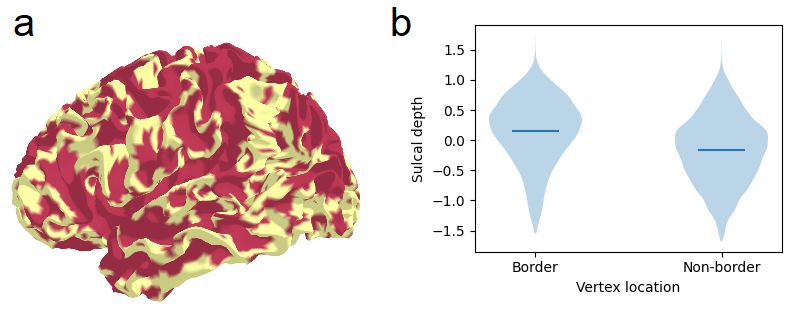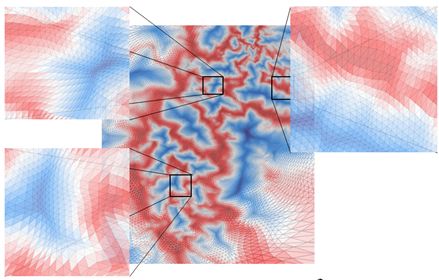On native meshes, gyral/sulcal differences were minimal or non-existent. In general, one good test would be to see if your outcomes (like myelination) co-varied with sulcal depth across the whole brain. If they do, then need to consider whether the relationship is artefactual or real.
25.02.2025 02:22 — 👍 2 🔁 0 💬 0 📌 0

Spurious correlations in surface-based functional brain imaging
Abstract. The study of functional MRI (fMRI) data is increasingly performed after mapping from volumetric voxels to surface vertices. Processing pipelines commonly used to achieve this mapping produce...
I'm proud of this work, and I hope this paper helps you to avoid spurious conclusions in your work. Check out the full paper (tinyurl.com/gyral) for a detailed breakdown and for other downstream analyses that can be impacted (FC fingerprinting, hyperalignment, etc). (5/5)
25.02.2025 00:36 — 👍 15 🔁 0 💬 0 📌 0
The new Onavg template promises to even out variability in inter-vertex spacing across the cortex. We tested this. This template reduces variability by 90% in the common surface space, but only by about 20% in subject-specific surfaces :( (4/5)
25.02.2025 00:36 — 👍 7 🔁 0 💬 1 📌 0

We then explored the consequences. Adjacent sulcal vertices have highly correlated fMRI time series just because they're closer. This can trick functional parcellations into putting parcel boundaries on gyri instead. (3/5)
25.02.2025 00:36 — 👍 4 🔁 0 💬 1 📌 0

This new visual by
@phogat_richa
shows it all. In this single-subject flattened cortex, we see mesh vertices and triangles with gyri (red) and sulci (blue). The triangles are clearly smaller in sulci (blue). All fsaverage and fsLR surfaces look like this. (2/5)
25.02.2025 00:36 — 👍 8 🔁 2 💬 2 📌 0
Do you work on surface MRI such as HCP data? Our paper is finally out in Imaging Neuroscience, showing biases in surface fMRI. The revised ms has many new insights!
TLDR: Vertices are much closer to each other in sulci, resulting in (fake) high spatial autocorrelation. (1/5)
25.02.2025 00:36 — 👍 53 🔁 22 💬 1 📌 7
Wow. Most recent openAI model o3 smashes the prev leaderboard for ARC reasoning challenge (an AGI benchmark). It is also now the 175th best coder in the world (CodeForces challenge), and can solve 25% of hard-for-humans FrontierMath Qs (up from 2%). What does this all mean?
21.12.2024 22:36 — 👍 2 🔁 0 💬 1 📌 0
A new podcast episode about a very persuasive theory of consciousness (from my favourite podcast host!)
#consci #neuroscience
open.spotify.com/episode/0ldz...
13.12.2023 19:17 — 👍 0 🔁 0 💬 0 📌 0
1. Imagine we land a space probe on one of Jupiters’ moons, take up a sample of material, and find it is full of organic molecules. How can we tell whether those molecules are just randomly assembled goo or the outcome of some evolutionary process taking place there? 🧪
13.10.2023 04:13 — 👍 421 🔁 171 💬 20 📌 61
Hi! I'm a psychiatry trainee and PhD student. Looking forward to engaging in conversations on human brain imaging, neuroscience, consciousness, and psychiatry! #HiSciSky #compneuro #neuroimaging #consci #interoception
25.09.2023 22:27 — 👍 20 🔁 4 💬 2 📌 0
PhD student at Mila interested in AI, cognitive neuroscience, and consciousness
assoc prof, uc irvine cogsci & LPS: perception+metacognition+subjective experience, fMRI+models+AI
meta-science, global education, phil sci
prez+co-founder, neuromatch.io
fellow, CIFAR brain mind & consciousness
meganakpeters.org
she/her 💖💜💙 views mine
Using deep learning to study neural dynamics
@mackelab.bsky.social
We build probabilistic #MachineLearning and #AI Tools for scientific discovery, especially in Neuroscience. Probably not posted by @jakhmack.bsky.social.
📍 @ml4science.bsky.social, Tübingen, Germany
PhD Student at Imperial College - deep learning, representation learning, information theory, and neuromorphic computing. Writing and poetry. Piano and classical music.
geresy.com
Studying language in biological brains and artificial ones @MIT.
www.tuckute.com
Neuroscientist at IISc Bangalore studying visual perception using 🐒🚶🏽♀️💻
https://sites.google.com/site/visionlabiisc/
PhD student @Columbia working towards approaching the theoretical upper bound of how much information we can read out from the brain 🧠
I am a science correspondent for BBC News. I post mostly about science, sometimes science journalism and very occasionally, Spurs. Please share any hot stories, ideas and opinions on all three and anything else currently inspiring you.
Computational Cognitive Scientist 🧠🤖 • NeuroAI, Predictive Coding, RL & Deep Learning, Complex Systems • Postdoc at @siegellab.bsky.social, @unituebingen.bsky.social • Husband & Dad
🎓 https://scholar.google.com/citations?hl=en&user=k5eR8_oAAAAJ
NeuroAI Scholar @ CSHL
https://darsnack.github.io
Previously maintaining FluxML to procrastinate
Previously EE PhD at UW-Madison, comp. eng. / math at Rose-Hulman
Theoretical Neuroscience, Deep Learning, & the space between.
Assistant Professor, Birla Institute of Technology & Science.
http://brain.bits-hyderabad.ac.in/venkat/
NeuroAI Curriculum Specialist @neuromatch & GenAI Technical Trainer. Ex-Postdoc @ Amii / UAlberta studying ML and brains. PhD & ex-Google Brain intern.
i like generative models, science, and Toronto sports teams
phd @ mila/udem, prev. @ uwaterloo
averyryoo.github.io 🇨🇦🇰🇷
minds and machines.
staff research scientist at google.
https://ghonk.github.io/
Ph.D. student: AI for Dynamics and Neuroscience at Mila Quebec & UMontreal
Student researcher at CHU-Sainte Justine
Physics grad @UWaterloo
Previously at DataforGood and Hexoskin
http://scholar.social/@mahta
X: @mahtaao
we must know. we will know.
https://scholar.google.com/citations?user=hG2vvYgAAAAJ&hl=en
A leading cause of In Silico #Neuroscience world-wide since 2010
https://neuro.plasticit.ai
neuromantic - ML and cognitive computational neuroscience - PhD student at Kietzmann Lab, Osnabrück University.
⛓️ https://init-self.com
wharton stats phd — ml theory, ml for science
prev: comp neuro, data, physics
working with Edgar Dobriban and Konrad Körding
also some sports (esp. philly! go birds)



